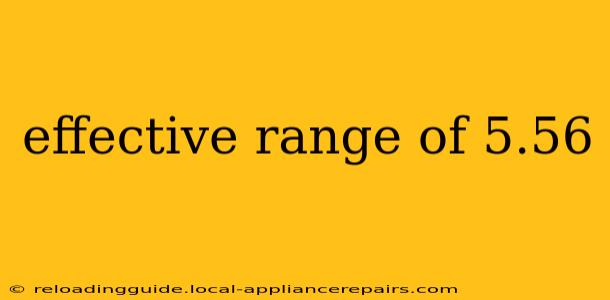The effective range of 5.56x45mm NATO ammunition is a frequently debated topic among firearms enthusiasts, military personnel, and competitive shooters. Understanding this range requires looking beyond simple bullet trajectory and considering several crucial factors influencing accuracy and lethality. This comprehensive guide will delve into the nuances of 5.56mm effective range, providing a clearer picture than simple, generalized statements.
Factors Affecting 5.56 Effective Range
The effective range isn't a single number; it's a dynamic concept dependent on several interacting variables. These include:
-
Ammunition Type: Different 5.56mm rounds exhibit varying ballistic characteristics. M193 ammunition, for instance, has a flatter trajectory than the M855, impacting effective range at longer distances. Furthermore, specialized ammunition like match-grade rounds designed for accuracy will perform differently than standard military issue.
-
Rifle and Barrel Length: A longer barrel allows more complete powder burn, resulting in higher muzzle velocity and increased effective range. Shorter barrels compromise velocity and thus, range.
-
Weapon Sight: The type of sighting system dramatically affects accuracy at range. Iron sights are limited by the shooter's eye and the sight's design, while optical sights like scopes or red dots offer significant advantages at longer distances.
-
Environmental Conditions: Wind, temperature, and humidity significantly impact bullet trajectory. Strong winds can cause substantial drift, while temperature affects bullet velocity and density of the air.
-
Shooter Skill: Even the best ammunition and weapon are useless without a skilled shooter. Proper shooting technique, including consistent breathing and trigger control, is paramount for accuracy at extended ranges.
-
Target Type: The definition of "effective" range changes depending on the target. A point target (like a small headshot) requires far more accuracy than a larger area target (like an enemy torso).
Defining "Effective Range"
The term "effective range" itself is ambiguous. It can refer to:
-
Maximum Effective Range: The greatest distance at which a round can reliably hit a target of a specific size. This might be defined by the probability of hitting a man-sized target, for example.
-
Point Target Range: The distance at which a round can consistently hit a small, precise target, such as the head of a human or the center of a bullseye.
-
Area Target Range: The distance at which a round can reliably inflict damage to a larger area target. This is a more forgiving measure than point target range.
-
Lethal Range: The maximum distance at which a round can reliably inflict a fatal injury. Factors like bullet energy, caliber, and shot placement all play a role in determining lethal range.
Practical Considerations for 5.56mm
While manufacturers and militaries might state maximum ranges, it’s crucial to understand those figures often relate to maximum bullet travel distance, not effective engagement distances. A round might travel for a mile, but its accuracy and lethality beyond 500-600 meters are significantly compromised for most scenarios, particularly against human targets. Many experts consider the effective range for a 5.56mm round against a human target to be significantly shorter – likely in the range of 300-500 meters under ideal conditions, with accuracy and lethality degrading rapidly beyond this distance.
Conclusion
The effective range of 5.56x45mm NATO ammunition isn't a single, definitive number. It's a complex interplay of factors ranging from ammunition type and weapon characteristics to environmental conditions and shooter proficiency. While longer ranges are possible, practical considerations of accuracy and lethality dictate that effective engagements generally remain within a shorter range for the majority of scenarios. Understanding these nuances is vital for responsible firearm use and tactical planning.

